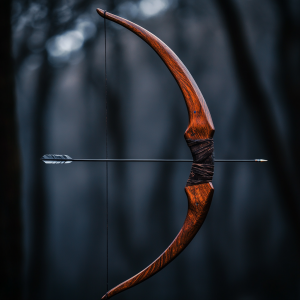
Bow and arrow have several advantages over a firearm
In a world where societal structures have broken down, the ability to survive and thrive becomes paramount. Among the myriad tools available for such scenarios, the bow and arrow stand out as a remarkably versatile and effective choice. This ancient weapon system, honed over millennia, offers numerous advantages in terms of stealth, food procurement, resource conservation, and self-defense.
One of the primary virtues of the bow and arrow is its silent operation. Unlike firearms, which produce loud reports that can be heard from great distances, a bow releases arrows with minimal noise. This stealth factor is crucial in several scenarios. When hunting, it allows you to take multiple shots without scaring away nearby game, increasing your chances of a successful hunt. In terms of security, it enables you to engage threats without revealing your position to others who might be nearby. In a chaotic environment where staying unnoticed can be vital for survival, the bow’s quiet nature is invaluable.
The bow and arrow excels as a hunting tool, providing a reliable means to procure food. Its versatility allows for hunting both small game like rabbits and birds, as well as larger animals such as deer or wild boar. Skilled archers can take down game from considerable distances, adding an extra layer of safety when hunting potentially dangerous animals. Moreover, unlike firearms, arrows cause less tissue damage, preserving more edible meat – a crucial factor when every resource counts.
In a long-term survival situation, the ability to reuse ammunition is invaluable, and this is where the bow and arrow truly shines. Most arrows can be retrieved after use, whether from a successful hunt or a missed shot. Well-made arrows are durable and can be used multiple times before needing replacement. Even when damaged, arrows can often be repaired with basic tools and materials found in nature, extending their lifespan significantly.
The multi-use nature of bow components adds to their value in a survival situation. Bowstrings, typically made from strong, flexible materials, can serve numerous functions beyond their primary purpose. They can be used for fishing lines, snares for small game, or as cordage for shelter building. In emergency situations, a bowstring could even serve as a tourniquet or be unraveled for suture material. Arrows, too, have multiple uses. The shaft can be repurposed as a drill for fire-starting, a splint for medical emergencies, or even as a tool for digging.

Bow and arrow can be used for hunting or for self-defense
Crafting arrows yourself is a valuable skill in a long-term survival scenario. While it requires practice and patience, the ability to create your own ammunition ensures a sustainable source of arrows. The process typically involves selecting straight branches or saplings for the shaft, carefully straightening them using heat if necessary. Feathers from birds you’ve hunted can be used for fletching, attached with natural adhesives like pine resin. Arrowheads can be crafted from knapped stone, bone, or even hardened wood, depending on the available materials and intended use of the arrow.
While not as immediately lethal as firearms, bows can be effective for self-defense. Their silent operation allows for engagement without attracting additional attention – a crucial factor in potentially hostile environments. The sight of a drawn bow can be a powerful deterrent, potentially defusing confrontations without the need for violence. For situations requiring a non-lethal response, blunt arrows or less powerful draws can be employed, providing a flexible response to various threat levels.
The bow and arrow system also offers advantages in terms of maintenance and long-term sustainability. Unlike firearms, which require specific ammunition and can be prone to mechanical failures, bows are relatively simple mechanisms with fewer points of failure. They require minimal upkeep, and most maintenance can be performed with basic tools and materials. Once initial supplies run out, new arrows can be crafted from natural materials, ensuring a continual supply of ammunition.

bow and arrow can be used to take down game
The bow and arrow, with its silent operation, sustainable ammunition, and versatility in both hunting and self-defense, proves to be an excellent tool for long-term survival scenarios. It take skill, and it’s not easy to cloak like a firearm, but its ability to provide food, offer protection, and operate with minimal resource consumption makes it a timeless tool for survival. While it requires skill and practice to master, the multitude of benefits it offers in a societal breakdown situation make the bow and arrow a valuable addition to any preparedness plan. Its rich history as a tool for human survival is a testament to its enduring value, even in our modern age.
Join us on Facebook at www.facebook.com/preparednesspro


